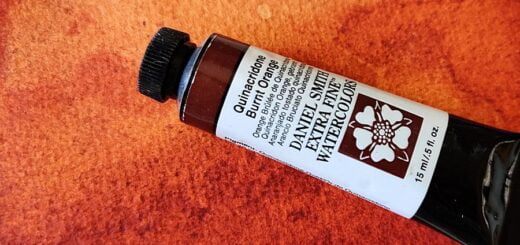Burnt Sienna

Sienna is in its original form a yellow-brown earth color. If you heat up the natural sienna pigment, it becomes redder and darker. This red and dark color is called burnt, the original is called raw.. Read more about this here.
The color is, as I see it, an absolute must in every watercolor painter’s color set. If you only own one brown color, it should be burnt sienna. It is much more versatile than darker browns such as burnt umbra, namely, it is easy to make a light color dark, but impossible to make a dark color light. This is not to say that you should not have umbra or any other brown, but if you have to choose, it must be sienna.
Some of my requirements for a burnt sienna:
- It must have a beautiful orange-brown hue, preferably color intense.
- It should turn gray when mixed with either French ultramarine or cobalt blue (two major blue colors).
- It must be at least semi-transparent, preferably completely transparent.
- If it is available in large tubes, it is a plus, because I use quite a lot of burnt sienna.
The most common pigment for Burnt Sienna is PBr7 which is supposed to be natural iron oxide, nowadays it is the case that the natural pigment is replaced by synthetic mixtures, read more about this here. Another, also common pigment is PR101 which is synthetic red iron oxide, it can be more colorful than PBr7. Some manufacturers mix different iron oxides and even black to achieve their version of burnt sienna.
Like raw sienna, burnt sienna can vary greatly depending on the manufacturer. Some are opaque and blackish, while others are purer in color, some are reddish while others are bright orange, some are almost dark yellow-brown.
Personally, I prefer burnt sienna from Winsor & Newton, I like the clear saturated orange hue, the color is also very transparent, it makes it possible to mix very dark colors with French ultramarine (or other blue). It is so saturated that you have to dim it with a little blue color for it to be natural, as I see it, this is an advantage. The pigment they use is PR101, which is synthetic red iron oxide.


I also use another burnt sienna when I need a more natural color, namely Italian Burnt Sienna from Daniel Smith which is made from real earth pigments. Like many others, DS lists the pigment as PBr7, but unlike other manufacturers, it really is PBr7. The color is only semi-transparent and slightly lighter than burnt sienna from W&N. In other words, it is more difficult to mix to really dark colors. But the color is beautiful natural orange-brown and it granulates, which is also a plus for me. However, never buy ordinary burnt sienna from DS, I do not know what made them make such a color, it can not be used, bland and boring.
Burnt sienna is no longer a specific pigment, it is a manufacturer’s vision of the color. They are all different, so you as a consumer must choose. Which one you choose is a matter of taste, it can be difficult to find the right one, you probably choose the one that your favorite brand has, but there may be something else that suits you better. Here’s a little video by Eve Bolt, it’s a good review of different burned sienna from different manufacturers.














Speaking of such, here I have found an explanation on Burt Siennas versions.Mine is “Burnt Sienna Deep PR101” by Da Vinci. I might say it’s identical to that of Winsor & Newton. It’s a very strong pigment indeed, a tiny amount goes a long way and I only have used it mixed with ultramarine blue, never on its own.
I watched the excellent informational video 👍🏻